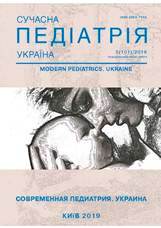Physical activity and physical development of school age children
Abstract
The aim of the research: to study physical activity of school age children and its influence on their physical development and adaptive possibilities of the cardiovascular system.Materials and methods. 290 children in age 10–17 were examined: pupils of 5–11th classes of two schools in Kharkiv. There were 141 boys and 149 girls. Anthropometry was carried out, physical activity was studied using the questionnaire of PAQ-C (The Physical Activity Questionnaire for Children), physical activity tolerance was assessed using the Ruffie's test.
Results. It has been established that dysgarmonic physical development was observed in 24.18% of children 11–16 years old, mainly due to excessive body weight (10.25%) and body weight deficiency (9.84%). Obesity was found in 4.10% of children. Low body weight, excessive body weight and obesity were observed predominantly in children 11–12 years old, regardless of sex. Boys aged 14 to 16 years are also characterized by increased number of patients with excessive body weight and obesity. In general, 58.3±2.9% of children had low physical activity during the week. Between the ages of 11 and 17 (from 5 to 11 class), from 45% to 88%, the number of boys and girls with hypodynamia increases. Low physical activity was accompanied by decreased tolerance to physical activity in children with different levels of physical development. At the same time, the highest correlation coefficient was observed in children with low body weight (r=0.659; p<0.02). Most boys had satisfactory adaptive capabilities of the heart. Reduced tolerance to physical activity was observed in 20.83% of boys with excessive body weight, as well as in 28.57% with harmonious physical development. Among girls, 53.85% with overweight and 42.37% with normal body weight had low tolerance to physical activity. Children's body weight deficiency was also often accompanied by a reduction in adaptive capacity: 57.14% of boys and 54.55% of girls with low body weight had lower tolerance to physical activity. Unsatisfactory results of the Ruffie’s test in 89% of cases were shown by children with low physical activity.
Conclusion. Physical activity and physical development of children affect the adaptive capacity of the growing organism. Adequate physical activity supports satisfactory adaptive capacity parameters, which was observed in most overweight boys.
The research was carried out in accordance with the principles of the Helsinki Declaration. The study protocol was approved by the Local Ethics Committee (LEC) of all institutions.
References
Bondarenko ІG, Bondarenko OV. (2017). Ruhova aktivnіst' shkoljarіv Norvegії v sistemі fіzichnogo vihovannja. Naukova pracja. Pedagogіka. 279: 125–129.
Gelashvili OA, Hisamov RR, Shal'neva IR. (2018). Fizicheskoe razvitie detej i podrostkov. Sovremennye problemy nauki i obrazovanija. 3.
Global'nye rekomendacii po fizicheskoj aktivnosti dlja zdorov'ja. (2009). WHO Library Cataloguing-in-Publication Data. https://apps.who.int/iris/bitstream/handle/10665/44399/9789244599976_rus.pdf;jsessionid=ADF2CD67072A0D1AA04506C1EAE1C51C?sequence=3
Kalinichenko ІO. (2014). Gіgіenіchna ocіnka dobovoї ruhovoї aktivnostі dіtej 7–17 rokіv. Sportivna medicina. 1: 36–40.
Kovalenko VM, Kornac'kij VM. (2016). Problemi zdorov`ja і medichnoї dopomogi ta model' pokrashhannja v suchasnih umovah. Kyiv: 261.
Levandovs'ka L. (2013). Osnovi ta kriterії optimal'nogo normuvannja ruhovoї aktivnstі shkoljarіv starshih klasіv. Fіzichne vihovannja, sport і kul'tura zdorov'ja u suchasnomu suspіl'stvі: zbіrnik nauk. prac'.1(21):181–185.
Mandjuk A. (2015). Osoblivostі ruhovoї aktivnostі shkoljarіv u SShA. Moloda sportivna nauka Ukraїni. L'vіv. 2: 167–172.
Oficial'nyj sajt Parlamenta Norvegії. https://www.stortinget.no/no/Saker-og-publikasjoner/Publikasjoner/Representantforslag/2015-2016/dok8-201516-092/.
Pro zatverdzhennja Kriterіїv ocіnki fіzichnogo rozvitku dіtej shkіl'nogo vіku (2013): Nakaz MOZ Ukraїni No. 802 vіd 13.09.2013. https://zakon.rada.gov.ua.
Pro shvalennja Koncepcії derzhavnoї cіl'ovoї socіal'noї programi rozvitku fіzichnoї kul'turi ta sportu v Ukraїnі na perіod do 2020 roku: Rozporjadzhennja Kabіnetu Mіnіstrіv Ukraїni. http://zakon3.rada.gov.ua/laws/show/1320-2015/r
Tomenko OA. (2013). Rіven' ruhovoї aktivnostі shkoljarіv ta shljahi jogo pіdvishhennja v umovah zagal'noosvіtn'oї shkoli. Slobozhans'kij naukovo/sportivnij vіsnik. 3: 19–23.
Booth ML, Okely AD, Chey TN et al. (2002). The reliability and validity of the Adolescent Physical Activity Recall Questionnare. Med SciSport Exerc. 34;12: 1986–1995. https://doi.org/10.1097/00005768-200212000-00019; PMid:12471306
Hagstromer M, Oja P, Sjostrom M. (2005). The International Physical Activity Questionnaire (IPAQ) :a study of concurrent and construct validity. Public Health Nutrition. 9;6: 755–762. https://doi.org/10.1079/PHN2005898; PMid:16925881
Submission to the World Health Organization (WHO) on the Draft WHO Global Action Plan on Physical Activity 2018–2030
WHO (2008). 2008–2013 Action Plan for the Global Strategy for the Prevention and Control of Noncommunicable Diseases. Geneva: WHO.
Downloads
Issue
Section
License
The policy of the Journal “MODERN PEDIATRICS. UKRAINE” is compatible with the vast majority of funders' of open access and self-archiving policies. The journal provides immediate open access route being convinced that everyone – not only scientists - can benefit from research results, and publishes articles exclusively under open access distribution, with a Creative Commons Attribution-Noncommercial 4.0 international license (СС BY-NC).
Authors transfer the copyright to the Journal “MODERN PEDIATRICS. UKRAINE” when the manuscript is accepted for publication. Authors declare that this manuscript has not been published nor is under simultaneous consideration for publication elsewhere. After publication, the articles become freely available on-line to the public.
Readers have the right to use, distribute, and reproduce articles in any medium, provided the articles and the journal are properly cited.
The use of published materials for commercial purposes is strongly prohibited.

